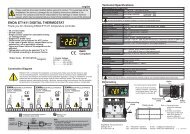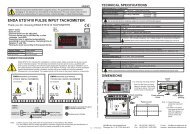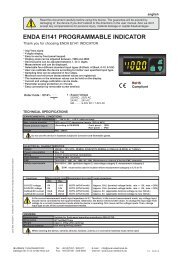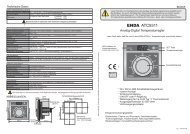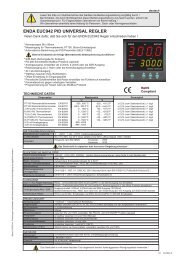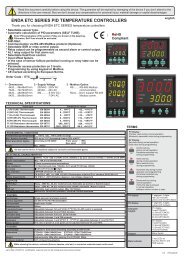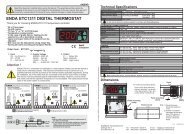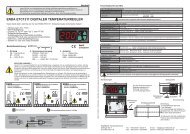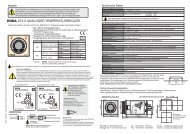enda euc942 pid universal controller - SURAN Industrieelektronik
enda euc942 pid universal controller - SURAN Industrieelektronik
enda euc942 pid universal controller - SURAN Industrieelektronik
- No tags were found...
You also want an ePaper? Increase the reach of your titles
YUMPU automatically turns print PDFs into web optimized ePapers that Google loves.
SETCSETASETSETIf key is pressed while holding key, the programming mode is enabled.ASETCSETCon.o.ASETALr.o.ASETConF.ASETPage 3/5Pb4tý4.0td1.00Ct20P.SEt.0C.HyS.2C.StA.HEAtPr.Er.0C.oT.S.Out1S.S.T.S.0A.o.L.L.Pb = Proportional band.Adjustable between 0% and 100%Setting Pb = 0% On-Off control isselected.Ti = Integral time.Adjustable between 0.0 and 100.0 minutes.If ti = 0.0, integral effect is not used.Setting Pb = 0 this parameter is not seen.td = Derivative time.Adjustable between 0.00 and 25.00 minutes.If td = 0.00, derivation effect is not used.Setting Pb = 0 this parameter is not seen.Ct = Control period.Adjustable between 1 and 250 seconds.Setting Pb = 0 andC.ot.S.= Out1 thisparameter is not seen.P.SEt. = The ratio of output power at the setpoint.Adjustable between 0% and 100%.If this parameter is set to 0, the output powerbecomes 0 at the set point. If it is adjusted to50% output power becomes 50% at the setpoint. Using this parameter the energyrequirements of the system is adjusted at theset point. So the set point can be achieved byminimum fluctuations and in the shortest time.Setting Pb = 0, this parameter is not seen.C.HYS. = Hysteresis of the control output.Adjustable between 1 and 50 °C/F.Adjustable between 0,1 and 50 °C/F ,if inp = Pt.0.Setting Pb = 0 this parameter is seen.C.StA. = Configuration of the control output.C.StA. = HEAt means heating control.C.StA. = cooL means cooling control.Pr.Er. = This parameter is used to adjust thecontrol output during a sensor failure.Adjustable between 0% and 100%.If this parameter is adjusted to a value closer tothe energy requirements of the system at the setpoint, process temperature is prevented to rise ordrop to dangerous levels.C.ot.S. = Type of control outputout1 = Out1 control output.0-20 = Analog control output.( 0mA %0 energy, 20mA %100 energy)Out1 = Alarm2 output.4-20 = Analog control output.( 4mA %0 energy, 20mA %100 energy)Out1 = Alarm2 output.s.s.r = SSR control output..Out1 = Alarm2 output.S.S.t.S. = Soft Star timer set point valueThis parameter indicates the time to reach setpoint value when the device is first enegised.Adjustable between 0 and 250 minutes.If 0 is selected, soft start feature will be enableand the device reaches set point value quickly.NOTE! Setting Pb = 0, softstart feature will bedisable.A.o.L.L. =Minimum analog output value(% output) ,adjustable between 0 and 100.A1.Hy.2A1.tp.ýndE.A1.St.Hý.A1.P.e.onA2.Hy.2A2.tp.ýndE.A2.St.Hý.A2.P.e.oFFA1. Hy. = Hysteresis of the Alarm1output.Adjustable between 1 and 50°C.A1.tP. = Function of Alarm1 output.Four kinds of functions can beselected.indE. = IndependentdE. = DeviationbAnd = BandbAn.i. = Band with inhibitionA1.St. = The state of Alarm1.If independent or deviation alarm isselected, this parameter can be Lo.and Hi. . For Lo. alarm output isenergized below the alarm set point.For Hi. alarm output is energizedabove the alarm set point. If bandalarm is selected, this parameter canbebIHI or boHI. bIHI meansalarm is activated inside theband. boHI means alarm is activatedoutside the band.A1.p.e. = State of Alarm1 output inthe case of sensor failure.If A1.p.e. = On , the alarm output isenergized during the sensor failure.If A1.p.e. = oFF, the alarm output is notenergized during the sensor failure.A2. Hy. = Hysteresis of the Alarm2output.Adjustable between 1 and 50°C.NOTE! IfC.ot.S. = .out1, thisparameter is not seen.A2.tP. = Function of Alarm2 output.Four kinds of functions can beselected.indE. = IndependentdE. = DeviationbAnd = BandbAn.i. = Band with inhibitionNOTE! IfC.ot.S. = .out1, thisparameter is not seen.A2.St. = The state of Alarm2.If independent or deviation alarm isselected, this parameter can be Lo.and Hi. . For Lo. alarm output isenergized below the alarm set point.For Hi. alarm output is energizedabove the alarm set point. If bandalarm is selected, this parameter canbebIHI or boHI. bIHI meansalarm is activated inside theband. boHI means alarm is activatedoutside the band.NOTE! IfC.ot.S. = .out1, thisparameter is not seen.A2.p.e. = State of Alarm2 output inthe case of sensor failure.If A2.p.e. = On, the alarm output isenergized during the sensor failure.If A2.p.e. = oFF, the alarm output is notenergized during the sensor failure.NOTE! IfC.ot.S. = .out1, thisparameter is not seen.ýnP.FE.cn.C.Hi.L.600C.Lo.L.0oFFS.0Unit°CA1.H.L.600A1.L.L.0A2.H.L.600A2.L.L.0fL.Co.5inP. = Type of input and scale.Pt = Pt 100 -200 to +600°CPt.0 = Pt 100 -99.0 to +300.0°CFE.cn. = J (Iron vs. Copper-Nickel) 0 to +600°Cnc.nA. = K (Nickel-Cr.vs. Nickel-Alum.) 0 to +1200°Cc.cn. = T (Copper vs. Copper-Nickel) 0 to +400°CP10.r. = S (Platinum-10%Rhodium vs. Pt.) 0 to +1600°CP13.r. = R (Platinum-13%Rhodium vs. Pt.) 0 to +1600°C0-20 = 0-20 mA -999 to 30004-20 = 4-20 mA -999 to 3000Note : If the selected input type is changed, the value ofC.Hi.L, C.Lo.L , A.Hi.L. , A.Lo.L. parameters changesautomatically.C.Hi.L. = Set point upper limit.IfInP. orUnIt.parameters are changed, the maximumvalue of theC.Hi.L.parameter changes to the maximumscale value of the selected input. The minimum value isthe value of C.Lo.L. parameter.C.LoL. = Set point lower limit.If InP. or UnIt. parameters are changed, the minimumvalue of theC.Lo.L.parameter changes to the minimumscale value of the selected input. The maximum value isthe value ofC.Hi.L.parameter.oFFS. = Offset value.Offset value is added to the measurement value.Adjusted between -99 and +99°C.The normal value is 0.UnIt = The temperature unit.Selectable as °C or °F.Note : If the temperature unit is changed, the value ofthe UPL. , Lol. , A.UP.L. , A.Lo.L. Parameters changesautomatically.NOTE! IfInpparameter is selected TC or Pt100, thisparameter is seen.A1.H.L = Alarm1 value upper limit.IfInP. orUnIt.parameters are changed, the maximumvalue of theA1.H.L.parameter changes to the maximumscale value of the selected input type. Minimum ofA1.H.L. parameter is the value ofA1.L.L.parameter.A1.L.L. = Alarm1 value lower limit.IfInP. orUnIt.parameters are changed, the minimumvalue of theA1.L.L.parameter changes to the minimumscale value of the selected input type. The maximumvalue is the value ofA1.H.L.parameter.A2.H.L = Alarm2 value upper limit.IfInP. orUnIt.parameters are changed, the maximumvalue of theA2.H.L.parameter changes to the maximumscale value of the selected input type. Minimum ofA2.H.L. parameter is the value ofA2.L.L.parameter.NOTE! IfC.ot.S. = .out1, this parameter is not seen.A2.L.L. = Alarm2 value lower limit.IfInP. orUnIt.parameters are changed, the minimumvalue of theA2.L.L.parameter changes to the minimumscale value of the selected input type. The maximumvalue is the value ofA2.H.L.parameter.NOTE! IfC.ot.S. = .out1, this parameter is not seen.fL.Co. = Coefficient of digital filter.Filter for display value.Adjustable between 1 and 32. If this parameter is 1,digital filter runs most quick. If the parameter is 31, thefilter run most slow. The value of parameter should beincreased in interference.A.o.H.L.A.o.H.L. =Maximum analog output value(% output) ,adjustable between 0 and 100.ConF. Page 3/5Modification of ParameterC.HyS.6SETCSETC.HyS.6SETCSETC.HyS.5SETCSETC.HyS.6SETCSETSETWhen holding key, the value of parameter flashes and using keys the requested value can be adjusted.CSETIfkey is pressed and held 0.6 seconds, the value of the selected parameter changes ra<strong>pid</strong>ly. If waited enough,the value increases 100 at each step. After 1 second following the release of the key, initial condition is returned.The same procedure is valid for the decrement key.2./5 EUC942-E



